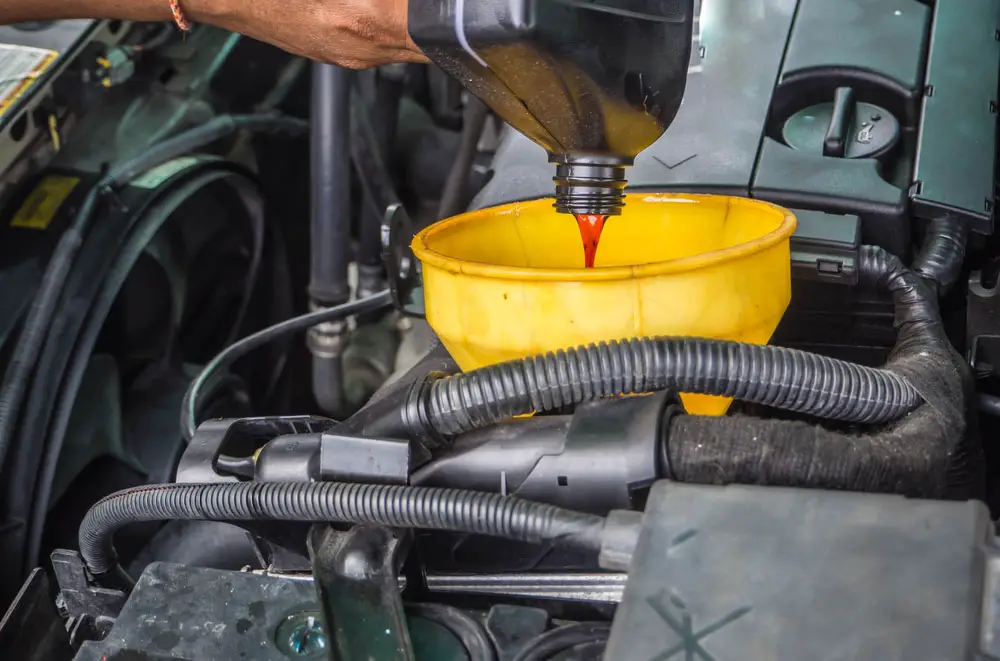How Much Transmission Fluid to Add If Empty?
If your transmission fluid levels are empty, start the engine and let it run for about five minutes or until it reaches operating temperature. After that, recheck the fluid levels and gradually add a quarter to half a quart of transmission fluid if necessary.
Repeat these steps until the dipstick reads full.

Step-by-Step Guide To Adding Transmission Fluid
- If your fluid levels are low, start the engine and let it run for about five minutes or until it reaches operating temperature.
- After that, recheck the fluid levels. If necessary, add a quarter to half a quart of transmission fluid gradually.
- Repeat the previous steps until the dipstick reads full.
- If you notice the transmission fluid is a little low on the dipstick, start with half a quart to a quart of transmission fluid.
- Recheck the level and add ¼ to ½ quart more if needed.
- If necessary, repeat the process until the dipstick reads full.
Adding the correct amount of transmission fluid is essential to ensure the smooth operation of your vehicle’s transmission. To add transmission fluid, start by gathering the necessary materials, including a funnel and the correct type of transmission fluid. Then, if your fluid levels are low, start the engine and let it run for about five minutes or until it reaches operating temperature.
After that, recheck the fluid levels using the dipstick and if necessary, gradually add a quarter to half a quart of transmission fluid. Allow the fluid to settle for a few minutes and then recheck the levels using the dipstick again. Repeat the previous steps until the dipstick reads full. This step-by-step guide will help you add the right amount of transmission fluid to your vehicle.</p
Common Questions About Adding Transmission Fluid
If your fluid levels are low, start the engine and let it run for about five minutes or until it reaches operating temperature. After that, recheck the fluid levels. If necessary, add a quarter to half a quart of transmission fluid gradually. Repeat the previous steps until the dipstick reads full.
If you notice the transmission fluid is a little low on the dipstick, start with a half a quart to a quart of transmission fluid. Recheck the level and add ¼ to ½ quart at a time until the dipstick shows full. This process may vary depending on the make and model of your car, so it’s always a good idea to consult your owner’s manual or a trusted mechanic for the correct amount.

Is there a negative effect of adding new transmission fluid without a flush?
Adding new transmission fluid without a flush may not always be the best solution. Transmission fluid serves as a lubricant for the transmission’s moving parts, and it also helps to cool and clean the system. However, it is important to keep in mind the condition of the existing fluid and any potential debris or contaminants that may be present.
What happens if the transmission fluid is added when the car is off?
Adding transmission fluid when the car is off is not recommended as the fluid needs to be circulated properly throughout the transmission system. It is best to add transmission fluid while the car is running to ensure proper distribution.
Can transmission fluid be added if the car has no fluid and has stopped moving?
If your car has no transmission fluid and has stopped moving, it may not be too late to add transmission fluid. However, it is important to address the underlying issue that caused the fluid to be depleted and determine if there is any damage to the transmission system.
Ultimately, the amount of transmission fluid needed will depend on your specific vehicle. It’s always a good idea to consult your owner’s manual or a trusted mechanic to determine the exact amount of transmission fluid required for your car.
Additional Tips And Considerations
If your fluid levels are low, start the engine and let it run for about five minutes or until it reaches operating temperature. After that, recheck the fluid levels. If necessary, add a quarter to half a quart of transmission fluid gradually. Repeat the previous steps until the dipstick reads full. It is important to refer to your car’s manual or consult a professional for the exact amount of fluid required. Regularly maintaining the transmission fluid levels is crucial for optimal performance.
However, it is important not to overfill the transmission fluid and to follow the manufacturer’s guidelines. By following these steps, you can ensure that your transmission is properly lubricated and functioning effectively.
Frequently Asked Questions On How Much Transmission Fluid To Add If Empty
How Many Quarts Of Transmission Fluid Do I Need If Empty?
To fill an empty transmission, gradually add a quarter to half a quart of transmission fluid until the dipstick reads full. Repeat the process if needed.
How Much Transmission Fluid Do I Add After Draining?
To add transmission fluid after draining, start your engine and let it run for about five minutes until it reaches operating temperature. Then, recheck the fluid levels. If needed, gradually add a quarter to half a quart of fluid at a time until the dipstick reads full.
Is It OK to Just Add Transmission Fluid?
Yes, it is okay to add transmission fluid without changing it. However, it’s important to note that adding new fluid to old fluid may not always be the best solution. Transmission fluid not only lubricates the transmission’s moving parts but also helps to cool and clean the system.
Conclusion
To ensure proper transmission functioning, it is essential to know how much transmission fluid to add if it’s empty. Start by running the engine for about five minutes or until it reaches operating temperature. Then, recheck the fluid levels and gradually add a quarter to half a quart of transmission fluid if necessary.
Repeat this process until the dipstick reads full. Remember, it is crucial to strike the right balance in adding new fluid without compromising the efficiency of the existing one. By following these steps, you can maintain the health of your transmission system.



